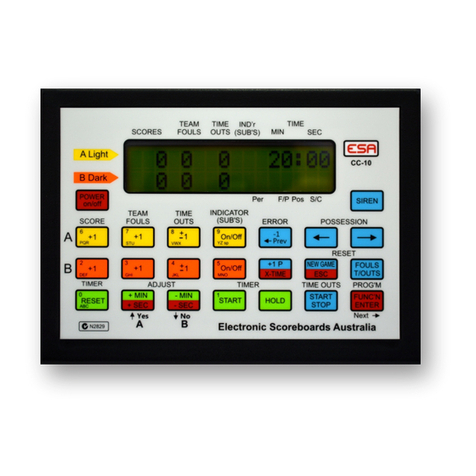
2.2 STANDARD FEATURES
Code Description
C4b Manual operation mode
By keyboard in Setup it is possible to select the operation mode. In manual mode, the control of the fan, the dP, C6 and
D5 are not active.
C7c1 Minimum dP alarm. Contact open with alarm. Automatic reset.
If the dP readout is below the threshold in Set up, the minimum dP alarm is activated. The display shows the alarm
condition code E8 (see the alarm description) or the dP readout and letter L alternatively, according to the model.
The corresponding alarm relay will signal its condition. The alarm is automatically reset when the dP readout is above
the threshold again.
If set to 'OFF' or 'E' (according to the model), the function is excluded.
NOTE: the minimum dP alarm is delayed by 60 seconds by default after the activation of the first cleaning cycle.
C7d1 Maximum dP alarm. Contact open with alarm. Automatic reset.
If the dP readout is above the threshold in Set up, the maximum dP alarm is activated. The display shows the alarm
condition code E7 (see the alarm description) or the dP readout and letter H alternatively, according to the model.
The corresponding alarm relay will signal its condition. The alarm is automatically reset when the dP readout is below
the alarm threshold again.
The activation of this alarm is delayed by 20 seconds by default.
C8 dP zero readout regulation
In this set up code it is possible to adjust the zero reading of differential pressure. In this function the display shows the
dP reading and, with plant stops or air pipes not connected if the dP reading is not 0.00 kPa it is possible to adjust it by
key A and C.
D14a Operation hours-counter
In Setup it is possible to visualize an hours counter. This counter is active when the cleaning cycle in On. In case of fan
stop, consent D6 not present or with the device in Setup the counter stops.
D1b1 Additional post-cleaning cycles from dP readout. Activation at STOP.
In automatic operation mode, you can add a pre-set number of cleaning cycles after the fan stop. Their number can be
set from 0 to 99 by keyboard. The sequencer will automatically recognise the fan state by comparing the dP readout
with the threshold in set code 11: dP > set 11 = fan on, dP < set 11 = fan off.
Post-cleaning cycles are activated even if dP = 0.
When the fan is off or dP < set 11, the display shows 'FAN STOP'.
The display shows 'POST-CLEANING ACT' during additional cycles and if there is no alarm.
Post-cleaning cycles are activated only if the dP readout should reach the threshold value of cycle STOP in normal
operation mode.
D5a Consent from external compressed air pressure switch
If the operation mode is automatic and contact D5a is open, the cleaning cycle stops, relay K2 indicates the alarm
situation. Close D5a to restart the washing cycle from the point where it had stopped. If contact D5a is open, the display
shows alarm code E6.
NOTE: Link D5a clamps if it is not used with inputs from external contact active (See Setup 5.1).
D6a ON/OFF cleaning cycle from external contact
If contact D6a is open, the cleaning cycle is not enabled and the display shows 'START CONTACT D6a OPEN'.
Close D6a to start cleaning cycle from the first electrovalve.
NOTE D6a: Jump D6a if it is not used with inputs from external contact active (See Setup 5.1).
G1 Maximum load power 25W per output
SL Multi language display
In Set up it is possible to select the language of all the descriptions showed by the display:
Italian, English, French, German, Spanish.
2.3 OPTION ON REQUEST
The presence of options on request could nullify or modify the operating of standard features.
Code Description
GSM1 GSM network connection for SMS sending in case of alarm
GSM network connection by Quad-Band modem 850/900/1800/1900 MHz.
When an alarm switch On, the device send an SMS to the mobile phone number insert in set up with the indication of
active alarm type (min. and max. dP alarms, dust emission alarms, electrovalves actiovation alarms).
By sending an SMS to the SIM mobile phone number of the device iy is possible switch Off all the alarms and receive
back a data string with some operating information:
Alarms reset command: SMS text = !a
Operating information datas sending command: SMS text = !i





























